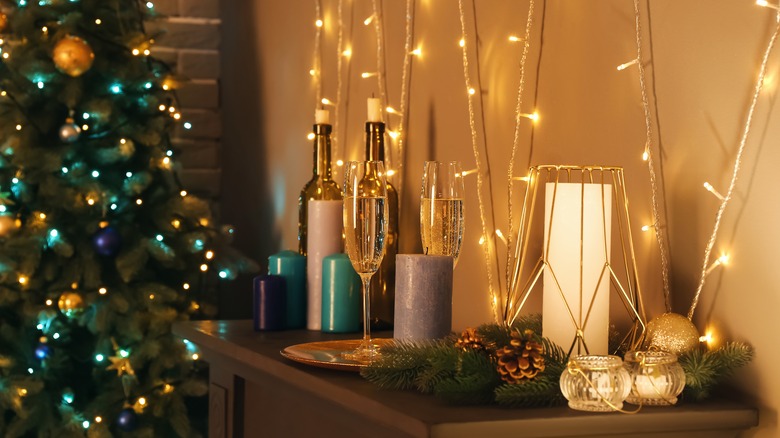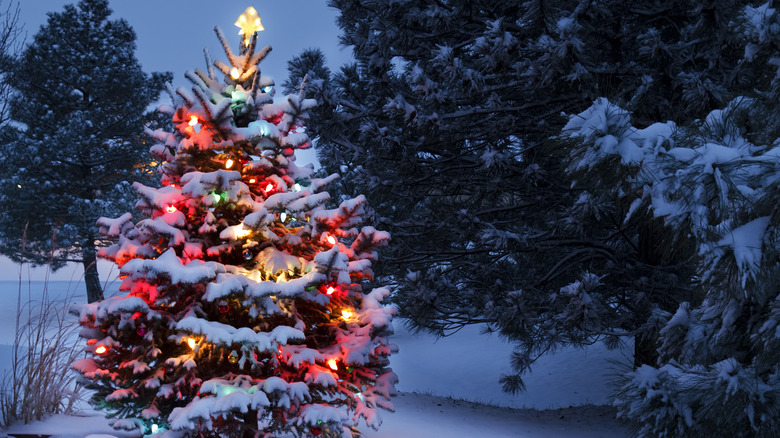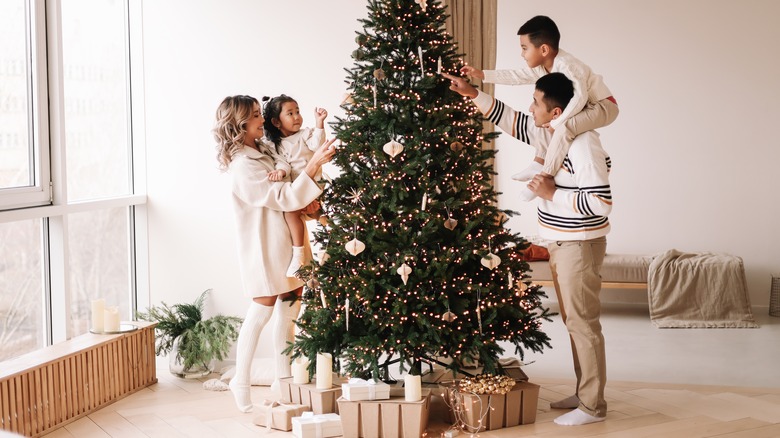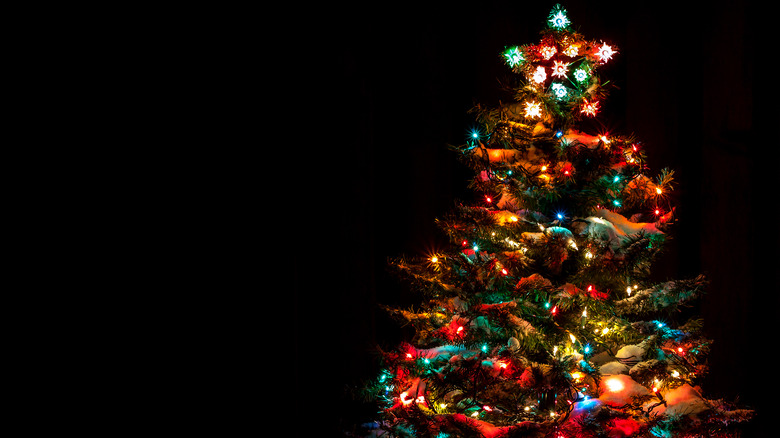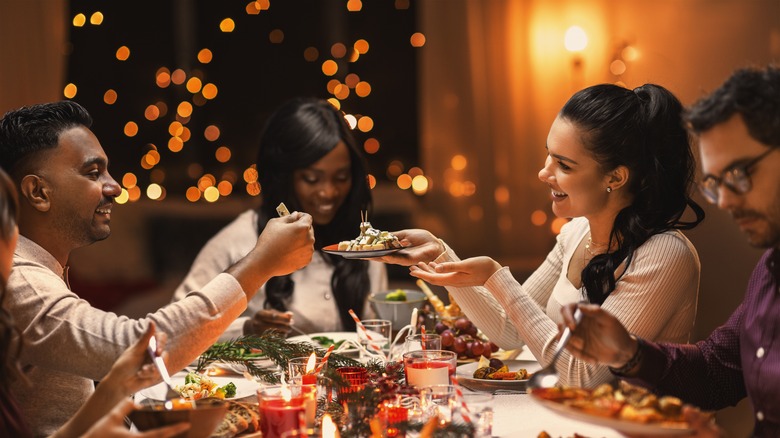White Christmas Lights Vs. Multi-Colored: Which Is The Right Choice For You?
The holiday season is upon us. So of course there's the timeless holiday décor question: white lights or multi-colored lights? According to Smithsonian Magazine, for decades, holiday trends have cycled in and out, and lights have gone from white to colorful, and back again. These days, people are free to choose whichever style of Christmas lights they prefer, but that doesn't mean we all know how to make the most informed décor decision.
While white lights are certainly classic, according to a Wakefield Research study with 1,000 participants, 62% said they prefer colorful lights to white lights, and 38% like white lights better. While multi-colored lights may have a few more fans than their monochrome competition, it's clear that folks are still split, and there's no one-size-fits-all answer to which lights you should hang up this year.
Depending on where exactly you fall on the scale from Scrooge to Clark Griswold, there are plenty of places you may want to hang Christmas lights this season. Where you're hanging your lights, of course, dictates what lights you should hang. Your personal style should also affect the lights you choose. Ultimately, the great white vs. colorful Christmas light debate isn't just about personal preference. Taking all the important points into consideration can be the difference between a holiday home where "all is calm; all is bright" and a complete clash of Christmas colors.
What aesthetic lights you up?
No matter what side of the Christmas light debate you're on, we can all agree that white lights and multi-colored lights give off very different vibes. White lights will certainly add that warm, cozy, Christmas-y ambiance that we all want in our homes this time of year. Lighting your Christmas tree with white lights will also let the other aspects of your tree shine through (no pun intended) and allow you to focus more on your ornaments, per Elle Decor.
Multi-colored lights, on the other hand, are more fun and whimsical, and they may even look more festive. It's common, too, for kids to prefer the lighthearted aesthetic of multi-colored lights, so they may be a good choice if your home will be getting a visit from Santa, per Schmidt Christmas Market. While there are plenty of things to consider when choosing your lights, which aesthetic you prefer and what vibe you want your lights to give off is really the best place to start.
Go with the flow of your style
Decorating for Christmas can be difficult because not many of us actually have bright red or dark green décor in our homes year-round. Consequently, many of us opt for more neutral holiday décor in white, gold, and silver to mesh with the rest of our space. This is a good instinct, especially if you have a colorful room. If this is the case for you, white lights are a foolproof choice. White lights are neutral and can tie together your space without making a statement that may conflict with your décor, via Southern Living.
If your house primarily involves neutral colors or has a primary color as an accent, multi-colored lights can provide a pop of color that will enhance your décor. This can also help you to tie in some more colorful holiday décor, like ornaments and garland (via Elle Decor). Alternatively, you may not want to alter your mild color scheme with colorful lights. Whichever style you want to go with, make sure to choose holiday décor that goes with your space, rather than fighting against it.
Embrace tradition
For many of us, the holiday season is a time for nostalgia and things that remind us of Christmastime growing up. Consequently, our childhood memories are an important part of the way many of us choose to decorate for the holidays. If you or a family member is particularly unwilling to compromise on your choice in lights, it's likely a bit deeper than just personal style. Clinical psychologist, Craig Sawchuk, told USA Today, "Rigidity in preferences can come from holding on to traditions. Their childhood memories, of going through the holiday season things were done this way, it may be a strong positive memory for them."
Multi-colored Christmas lights first became popular in the 1930s, per Smithsonian Magazine. Like all other trends, multi-colored Christmas lights cycled out and gave way to white lights. If white lights were what your parents always hung or colorful lights remind you of your grandma's Christmas tree, it's more than okay to lean into your happy memories and make your choice based on what you grew up loving. Alternatively, plenty of folks who are now faced with the important décor decision remember being denied their desire for multi-colored lights by a generation of moms who considered colorful lights "tacky," via the Chicago Tribune. Feel free to take the reins now and experiment.
How important are your lights?
We know, we know –– when it comes to holiday décor, lights are always important. They set the cozy mood and make your decorations pop. Still, how much of an impact you want your lights to have on your space matters when choosing which lights you're going to put up. Multi-colored lights make more of a statement and tend to have more of an impact. In fact, you can even do away with the need for ornaments on your tree if you're opting for a tree with multi-colored lights, via Southern Living. If you're using a lot of greenery, trees, and garland, white lights can be a perfect addition.
Ultimately, where you put your lights can have a lot of impact on your space and can even allow you to have the best of both worlds. Owner of holiday decorating company, Light Up Your Holidays, Kelly Fitzsimmons explained to the Chicago Tribune that having different colored lights in different places can really make all the difference: "If you want a classic, clean Christmas look in front, decorate a tree in the backyard with multicolored lights ... Do green and red bushes too." She suggests you can even "have two trees inside" to embrace all the lights the holiday season has to offer. When it comes to Christmas lights, the more the merrier and brighter.
